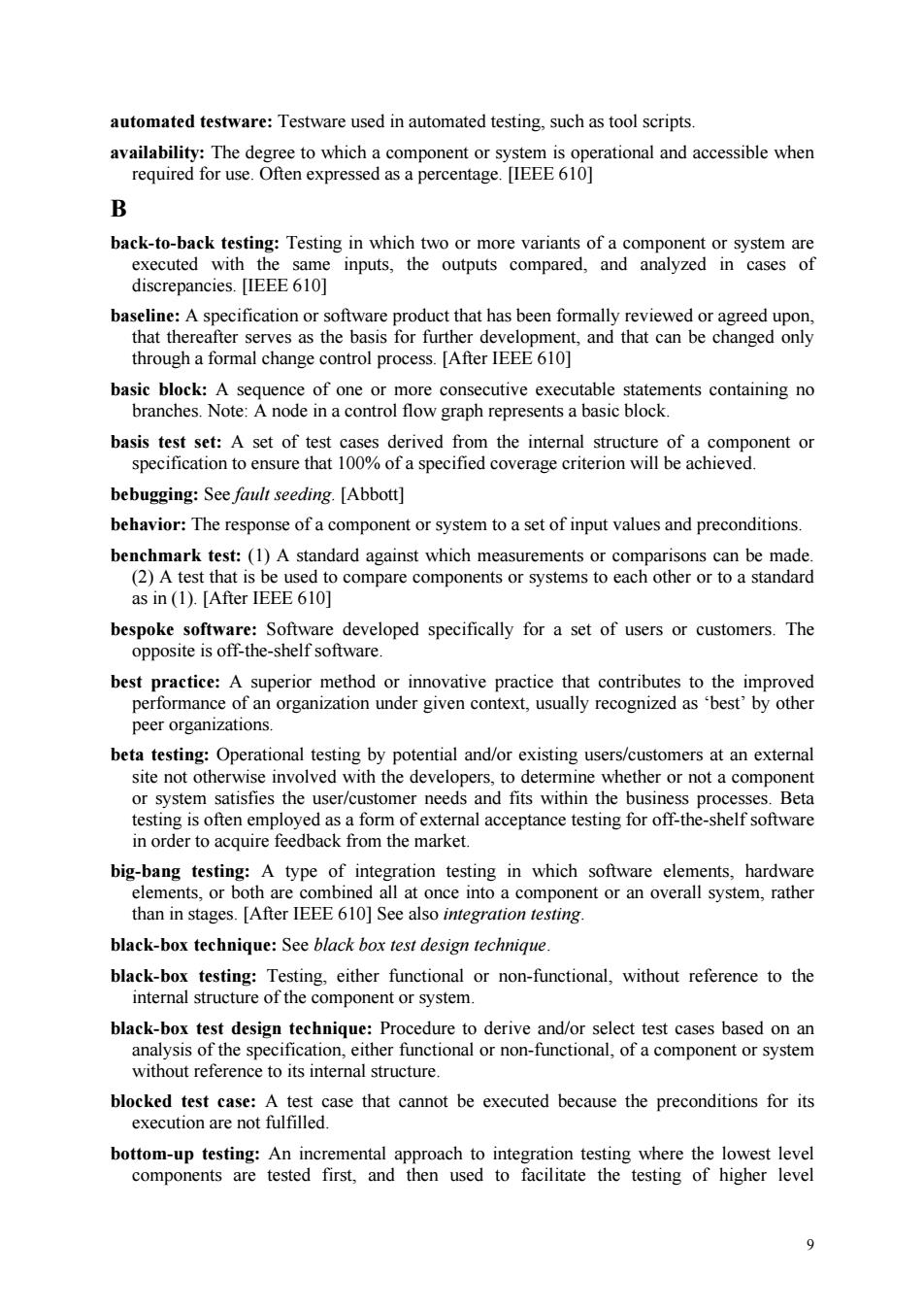正在加载图片...

automated testware:Testware used in automated testing.such as tool scripts. B back-to-back testing:Testing in which two or more variants of a component or system are executed with e inputs.the outputs compared,and analyzed in cases of baseline:a specification or softwar roduct that has been formally reviewed or eed u elor and that n he cha anged onl through a formal change control process.[After IEEE610] basic block:A sequence of one or more consecutive executable statements containing no branches.Note:A node in a control flow graph represents a basic block. basis test set:set of test s derived from the interal structure of a componentor specification to ensure that 100%of a specified coverage criterion will be achieved bebugging:See fault seeding.[Abbott] behavior:The response of a component or system to a set of input values and preconditions. benchmark test:(1)A standard against which measurements or comparisons can be made (2)A test that is be used to compare components or systems to each other or to a standard as in (1).[After IEEE 6101 developed specifically for a set of users or customers.The erior method or innovativ actice that c ontribu es to the in ext,usually recognized as be beta testing:Operational testing by potential and/or existing users/customers at an external site not otherwise involved with the developers,to determine whether or not a component or system satisfies the user/customer needs and fits within the business processes.Beta testing is often employed as a form of external acceptance testing for off-the-shelf software in order to acquire feedback from the market. A type of inte oth ware lem thanna ner 10ntor an ve s,hardw I system,rath black-box technique:See black box test design technique. black-box testing:Testing,either functional or non-functional,without reference to the internal structure of the component or system. black-box test design technique Procedure derive and/or select test cases based on an analysisfictionfunctionalo-funto without reference to its internal structure blocked test case:A test case that cannot be executed because the preconditions for its execution are not fulfilled. bottom-up testing:An incremental approach to integration testing where the lowest level components are tested first,and then used to facilitate the testing of higher level 9 9 automated testware: Testware used in automated testing, such as tool scripts. availability: The degree to which a component or system is operational and accessible when required for use. Often expressed as a percentage. [IEEE 610] B back-to-back testing: Testing in which two or more variants of a component or system are executed with the same inputs, the outputs compared, and analyzed in cases of discrepancies. [IEEE 610] baseline: A specification or software product that has been formally reviewed or agreed upon, that thereafter serves as the basis for further development, and that can be changed only through a formal change control process. [After IEEE 610] basic block: A sequence of one or more consecutive executable statements containing no branches. Note: A node in a control flow graph represents a basic block. basis test set: A set of test cases derived from the internal structure of a component or specification to ensure that 100% of a specified coverage criterion will be achieved. bebugging: See fault seeding. [Abbott] behavior: The response of a component or system to a set of input values and preconditions. benchmark test: (1) A standard against which measurements or comparisons can be made. (2) A test that is be used to compare components or systems to each other or to a standard as in (1). [After IEEE 610] bespoke software: Software developed specifically for a set of users or customers. The opposite is off-the-shelf software. best practice: A superior method or innovative practice that contributes to the improved performance of an organization under given context, usually recognized as ‘best’ by other peer organizations. beta testing: Operational testing by potential and/or existing users/customers at an external site not otherwise involved with the developers, to determine whether or not a component or system satisfies the user/customer needs and fits within the business processes. Beta testing is often employed as a form of external acceptance testing for off-the-shelf software in order to acquire feedback from the market. big-bang testing: A type of integration testing in which software elements, hardware elements, or both are combined all at once into a component or an overall system, rather than in stages. [After IEEE 610] See also integration testing. black-box technique: See black box test design technique. black-box testing: Testing, either functional or non-functional, without reference to the internal structure of the component or system. black-box test design technique: Procedure to derive and/or select test cases based on an analysis of the specification, either functional or non-functional, of a component or system without reference to its internal structure. blocked test case: A test case that cannot be executed because the preconditions for its execution are not fulfilled. bottom-up testing: An incremental approach to integration testing where the lowest level components are tested first, and then used to facilitate the testing of higher level